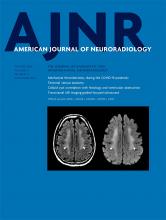Index by author
Pons-escoda, A.
- EDITOR'S CHOICEAdult BrainYou have accessPresurgical Identification of Primary Central Nervous System Lymphoma with Normalized Time-Intensity Curve: A Pilot Study of a New Method to Analyze DSC-PWIA. Pons-Escoda, A. Garcia-Ruiz, P. Naval-Baudin, M. Cos, N. Vidal, G. Plans, J. Bruna, R. Perez-Lopez and C. MajosAmerican Journal of Neuroradiology October 2020, 41 (10) 1816-1824; DOI: https://doi.org/10.3174/ajnr.A6761
The aims of this study were to: 1) to design a new method of postprocessing time-intensity curves, which renders normalized curves, and 2) to test its feasibility and performance on the diagnosis of primary central nervous system lymphoma. Time-intensity curves of enhancing tumor and normal-appearing white matter were obtained for each case. Enhancing tumor time-intensity curves were normalized relative to normal-appearing white matter. The authors performed pair-wise comparisons for primary central nervous system lymphoma against the other tumor type. The best discriminatory time points of the curves were obtained through a stepwise selection. Logistic binary regression was applied to obtain prediction models. A total of 233 patients were included in the study with 47 primary central nervous system lymphomas, 48 glioblastomas, 39 anaplastic astrocytomas, 49 metastases, and 50 meningiomas. The classifiers satisfactorily performed all bilateral comparisons in the test subset. They conclude that the proposed method for DSC-PWI time-intensity curve normalization renders comparable curves beyond technical and patient variability. Normalized time-intensity curves performed satisfactorily for the presurgical identification of primary central nervous system lymphoma.
Pope, M.C.
- SpineYou have accessSafety of Consecutive Bilateral Decubitus Digital Subtraction Myelography in Patients with Spontaneous Intracranial Hypotension and Occult CSF LeakM.C. Pope, C.M. Carr, W. Brinjikji and D.K. KimAmerican Journal of Neuroradiology October 2020, 41 (10) 1953-1957; DOI: https://doi.org/10.3174/ajnr.A6765
Pyatigorskaya, N.
- EDITOR'S CHOICEHead & NeckYou have accessAre Gadolinium-Enhanced MR Sequences Needed in Simultaneous 18F-FDG-PET/MRI for Tumor Delineation in Head and Neck Cancer?N. Pyatigorskaya, R. De Laroche, G. Bera, A. Giron, C. Bertolus, G. Herve, E. Chambenois, S. Bergeret, D. Dormont, M. Amor-Sahli and A. KasAmerican Journal of Neuroradiology October 2020, 41 (10) 1888-1896; DOI: https://doi.org/10.3174/ajnr.A6764
Consecutive patients who underwent simultaneous head and neck 18F-FDG-PET/MR imaging staging or restaging followed by surgery were retrospectively included in this study. Local tumor invasion and lymph node extension were assessed by 2 rater groups in 45 head and neck anatomic regions using 18F-FDG-PET/MR imaging. Two reading sessions were performed, one without contrast-enhanced sequences (using only T1WI, T2WI, and PET images) and a second with additional T1-weighted postcontrast sequences. The k concordance coefficient between the reading sessions and sensitivity and specificity for each region were calculated. There was excellent agreement between the contrast-free and postgadolinium reading sessions in delineating precise tumor extension in the 45 anatomic regions studied. The diagnostic accuracy did not differ between contrast-free and postgadolinium reading sessions, being 0.97 for both groups and both reading sessions. The authors conclude that gadolinium-based contrast administration showed no added value for accurate characterization of head and neck primary tumor extension and could possibly be avoided in the PET/MR imaging head and neck workflow.
Ramakrishnaiah, R.H.
- PediatricsOpen AccessMaternal Anxiety and Depression during Late Pregnancy and Newborn Brain White Matter DevelopmentR.M. Graham, L. Jiang, G. McCorkle, B.J. Bellando, S.T. Sorensen, C.M. Glasier, R.H. Ramakrishnaiah, A.C. Rowell, J.L. Coker and X. OuAmerican Journal of Neuroradiology October 2020, 41 (10) 1908-1915; DOI: https://doi.org/10.3174/ajnr.A6759
Riascos, R.F.
- Adult BrainYou have accessThe Variable Appearance of Third Ventricular Colloid Cysts: Correlation with Histopathology and the Risk of Obstructive VentriculomegalyS.D. Khanpara, A.L. Day, M.B. Bhattacharjee, R.F. Riascos, J.P. Fernelius and K.D. WestmarkAmerican Journal of Neuroradiology October 2020, 41 (10) 1833-1840; DOI: https://doi.org/10.3174/ajnr.A6722
Rigney, B.
- FELLOWS' JOURNAL CLUBAdult BrainOpen AccessImaging Features of Acute Encephalopathy in Patients with COVID-19: A Case SeriesS. Kihira, B.N. Delman, P. Belani, L. Stein, A. Aggarwal, B. Rigney, J. Schefflein, A.H. Doshi and P.S. PawhaAmerican Journal of Neuroradiology October 2020, 41 (10) 1804-1808; DOI: https://doi.org/10.3174/ajnr.A6715
The authors present 5 cases that illustrate varying imaging presentations of acute encephalopathy in patients with coronavirus disease 2019. MR features include leukoencephalopathy, diffusion restriction that involves the GM and WM, microhemorrhages, and leptomeningitis.
Rincon, S.
- SpineOpen AccessParaspinal Myositis in Patients with COVID-19 InfectionW.A. Mehan, B.C. Yoon, M. Lang, M.D. Li, S. Rincon and K. BuchAmerican Journal of Neuroradiology October 2020, 41 (10) 1949-1952; DOI: https://doi.org/10.3174/ajnr.A6711
Rincon, S.P.
- FELLOWS' JOURNAL CLUBAdult BrainOpen AccessClinical and Neuroimaging Correlation in Patients with COVID-19B.C. Yoon, K. Buch, M. Lang, B.P. Applewhite, M.D. Li, W.A. Mehan, T.M. Leslie-Mazwi and S.P. RinconAmerican Journal of Neuroradiology October 2020, 41 (10) 1791-1796; DOI: https://doi.org/10.3174/ajnr.A6717
This was a retrospective study performed at a large academic hospital in the United States. A total of 641 patients presented to the authors' institution between March 3, 2020 and May 6, 2020, for treatment of coronavirus disease 2019, of whom, 150 underwent CT and/or MR imaging of the brain. CT and/or MR imaging examinations were evaluated for the presence of hemorrhage, infarction, and leukoencephalopathy. Of the 150 patients, 26 (17%) had abnormal CT and/or MR imaging findings, with hemorrhage in 11 of the patients (42%), infarction in 13 of the patients (50%), and leukoencephalopathy in 7 of the patients (27%). Significant associations were seen between abnormal CT/MR imaging findings and intensive care unit admission, intubation, and acute kidney injury.
Roa, J.A.
- NeurointerventionYou have accessQuantifying Intra-Arterial Verapamil Response as a Diagnostic Tool for Reversible Cerebral Vasoconstriction SyndromeJ.M. Sequeiros, J.A. Roa, R.P. Sabotin, S. Dandapat, S. Ortega-Gutierrez, E.C. Leira, C.P. Derdeyn, G. Bathla, D.M. Hasan and E.A. SamaniegoAmerican Journal of Neuroradiology October 2020, 41 (10) 1869-1875; DOI: https://doi.org/10.3174/ajnr.A6772
Robert, T.
- Head & NeckOpen AccessStapedial Artery: From Embryology to Different Possible Adult ConfigurationsS. Bonasia, S. Smajda, G. Ciccio and T. RobertAmerican Journal of Neuroradiology October 2020, 41 (10) 1768-1776; DOI: https://doi.org/10.3174/ajnr.A6738
- Head & NeckOpen AccessMiddle Meningeal Artery: Anatomy and VariationsS. Bonasia, S. Smajda, G. Ciccio and T. RobertAmerican Journal of Neuroradiology October 2020, 41 (10) 1777-1785; DOI: https://doi.org/10.3174/ajnr.A6739








